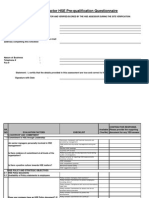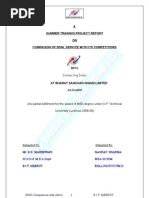An Introduction To Business Plans
An Introduction To Business Plans
Uploaded by
Al FarouqCopyright:
Available Formats
An Introduction To Business Plans
An Introduction To Business Plans
Uploaded by
Al FarouqOriginal Title
Copyright
Available Formats
Share this document
Did you find this document useful?
Is this content inappropriate?
Copyright:
Available Formats
An Introduction To Business Plans
An Introduction To Business Plans
Uploaded by
Al FarouqCopyright:
Available Formats
An Introduction to Business Plans Why is a business plan so vital to the health of your business?
Read the first section of our tutorial on How to Build a Business Plan to find out.
A business plan is a written description of your business's future. That's all there is to it--a document that desribes what you plan to do and how you plan to do it. If you jot down a paragraph on the back of an envelope describing your business strategy, you've written a plan, or at least the germ of a plan. Business plans can help perform a number of tasks for those who write and read them. They're used by investment-seeking entrepreneurs to convey their vision to potential investors. They may also be used by firms that are trying to attract key employees, prospect for new business, deal with suppliers or simply to understand how to manage their companies better. So what's included in a business plan, and how do you put one together? Simply stated, a business plan conveys your business goals, the strategies you'll use to meet them, potential problems that may confront your business and ways to solve them, the organizational structure of your business (including titles and responsibilities), and finally, the amount of capital required to finance your venture and keep it going until it breaks even. Sound impressive? It can be, if put together properly. A good business plan follows generally accepted guidelines for both form and content. There are three primary parts to a business plan:
The first is the business concept, where you discuss the industry, your business structure, your particular product or service, and how you plan to make your business a success. The second is the marketplace section, in which you describe and analyze potential customers: who and where they are, what makes them buy and so on. Here, you also describe the competition and how you'll position yourself to beat it.
Finally, the financial section contains your income and cash flow statement, balance sheet and other financial ratios, such as break-even analyses. This part may require help from your accountant and a good spreadsheet software program.
Breaking these three major sections down even further, a business plan consists of seven key components: 1. Executive summary 2. Business description 3. Market strategies 4. Competitive analysis 5. Design and development plan 6. Operations and management plan 7. Financial factors
In addition to these sections, a business plan should also have a cover, title page and table of contents.
How Long Should Your Business Plan Be?
Depending on what you're using it for, a useful business plan can be any length, from a scrawl on the back of an envelope to, in the case of an especially detailed plan describing a complex enterprise, more than 100 pages. A typical business plan runs 15 to 20 pages, but there's room for wide variation from that norm. Much will depend on the nature of your business. If you have a simple concept, you may be able to express it in very few words. On the other hand, if you're proposing a new kind of business or even a new industry, it may require quite a bit of explanation to get the message across. The purpose of your plan also determines its length. If you want to use your plan to seek millions of dollars in seed capital to start a risky venture, you may have to do a lot of explaining and convincing. If you're just going to use your plan for internal purposes to manage an ongoing business, a much more abbreviated version should be fine.
Plan an Updating Checklist
Here are seven reasons to think about updating your business plan. If even just one applies to you, it's time for an update. 1. A new financial period is about to begin. You may update your plan annually, quarterly or even monthly if your industry is a fast-changing one.
2. You need financing, or additional financing. Lenders and other financiers need an updated
plan to help them make financing decisions.
3. There's been a significant market change. Shifting client tastes, consolidation trends among
customers and altered regulatory climates can trigger a need for plan updates.
4. Your firm develops or is about to develop a new product, technology, service or skill. If your
business has changed a lot since you wrote your plan the first time around, it's time for an update.
5. You have had a change in management. New managers should get fresh information about
your business and your goals.
6. Your company has crossed a threshold, such as moving out of your home office, crossing the
$1 million sales mark or employing your 100th employee. 7. Your old plan doesn't seem to reflect reality any more. Maybe you did a poor job last time; maybe things have just changed faster than you expected. But if your plan seems irrelevant, redo it.
Finding the Right Plan for You.
Business plans tend to have a lot of elements in common, like cash flow projections and marketing plans. And many of them share certain objectives as well, such as raising money or persuading a partner to join the firm. But business plans are not all the same any more than all businesses are.
Depending on your business and what you intend to use your plan for, you may need a very different type of business plan from another entrepreneur. Plans differ widely in their length, their appearance, the detail of their contents, and the varying emphases they place on different aspects of the business. The reason that plan selection is so important is that it has a powerful effect on the overall impact of your plan. You want your plan to present you and your business in the best, most accurate light. That's true no matter what you intend to use your plan for, whether it's destined for presentation at a venture capital conference, or will never leave your own office or be seen outside internal strategy sessions. When you select clothing for an important occasion, odds are you try to pick items that will play up your best features. Think about your plan the same way. You want to reveal any positives that your business may have and make sure they receive due consideration.
Types of Plans
Business plans can be divided roughly into four separate types. There are very short plans, or miniplans. There are working plans, presentation plans and even electronic plans. They require very different amounts of labor and not always with proportionately different results. That is to say, a more elaborate plan is not guaranteed to be superior to an abbreviated one, depending on what you want to use it for.
The Miniplan. A miniplan may consist of one to 10 pages and should include at least cursory attention to such key matters as business concept, financing needs, marketing plan and financial statements, especially cash flow, income projection and balance sheet. It's a great way to quickly test a business concept or measure the interest of a potential partner or minor investor. It can also serve as a valuable prelude to a full-length plan later on.
Be careful about misusing a miniplan. It's not intended to substitute for a full-length plan. If you send a miniplan to an investor who's looking for a comprehensive one, you're only going to look foolish.
The Working Plan. A working plan is a tool to be used to operate your business. It has to be long on detail but may be short on presentation. As with a miniplan, you can probably afford a somewhat higher degree of candor and informality when preparing a working plan.
A plan intended strictly for internal use may also omit some elements that would be important in one aimed at someone outside the firm. You probably don't need to include an appendix with resumes of key executives, for example. Nor would a working plan especially benefit from, say, product photos. Fit and finish are liable to be quite different in a working plan. It's not essential that a working plan be printed on high-quality paper and enclosed in a fancy binder. An old three-ring binder with "Plan" scrawled across it with a felt-tip marker will serve quite well. Internal consistency of facts and figures is just as crucial with a working plan as with one aimed at outsiders. You don't have to be as careful, however, about such things as typos in the text, perfectly conforming to business style, being consistent with date formats and so on. This document is like an
old pair of khakis you wear into the office on Saturdays or that one ancient delivery truck that never seems to break down. It's there to be used, not admired.
The Presentation Plan. If you take a working plan, with its low stress on cosmetics and impression, and twist the knob to boost the amount of attention paid to its looks, you'll wind up with a presentation plan. This plan is suitable for showing to bankers, investors and others outside the company.
Almost all the information in a presentation plan is going to be the same as your working plan, although it may be styled somewhat differently. For instance, you should use standard business vocabulary, omitting the informal jargon, slang and shorthand that's so useful in the workplace and is appropriate in a working plan. Remember, these readers won't be familiar with your operation. Unlike the working plan, this plan isn't being used as a reminder but as an introduction. You'll also have to include some added elements. Among investors' requirements for due diligence is information on all competitive threats and risks. Even if you consider some of only peripheral significance, you need to address these concerns by providing the information. The big difference between the presentation and working plans is in the details of appearance and polish. A working plan may be run off on the office printer and stapled together at one corner. A presentation plan should be printed by a high-quality printer, probably using color. It must be bound expertly into a booklet that is durable and easy to read. It should include graphics such as charts, graphs, tables and illustrations. It's essential that a presentation plan be accurate and internally consistent. A mistake here could be construed as a misrepresentation by an unsympathetic outsider. At best, it will make you look less than careful. If the plan's summary describes a need for $40,000 in financing, but the cash flow projection shows $50,000 in financing coming in during the first year, you might think, "Oops! Forgot to update that summary to show the new numbers." The investor you're asking to pony up the cash, however, is unlikely to be so charitable.
The Electronic Plan. The majority of business plans are composed on a computer of some kind, then printed out and presented in hard copy. But more and more business information that once was transferred between parties only on paper is now sent electronically. So you may find it appropriate to have an electronic version of your plan available. An electronic plan can be handy for presentations to a group using a computer-driven overhead projector, for example, or for satisfying the demands of a discriminating investor who wants to be able to delve deeply into the underpinnings of complex spreadsheets.
You might also like
- Case Study of Mini StopDocument13 pagesCase Study of Mini StopMarie Reyes25% (4)
- 12 Francis Bacon Functions of Education in Society: Learning Activity 1Document5 pages12 Francis Bacon Functions of Education in Society: Learning Activity 1jessamae gundanNo ratings yet
- Chapter 6 Lesson 3 Media and The AudienceDocument17 pagesChapter 6 Lesson 3 Media and The AudienceKristelleNo ratings yet
- III12 q1 Mod3 ReadingonRelatedStudies Abcdpdf PDF To WordDocument32 pagesIII12 q1 Mod3 ReadingonRelatedStudies Abcdpdf PDF To WordChrisjhel EturaldeNo ratings yet
- Physical Education and Health 2 M7Document2 pagesPhysical Education and Health 2 M7Ericka Rivera SantosNo ratings yet
- Week 9: Author: Butch C. Cabanig Lay-Out Artist: Herma C. VejeranoDocument21 pagesWeek 9: Author: Butch C. Cabanig Lay-Out Artist: Herma C. VejeranoBEBERLIE GALOSNo ratings yet
- Properties of Well Written TextDocument2 pagesProperties of Well Written TextCharmaine Claire Tattao100% (1)
- Module 4 Activities 1Document6 pagesModule 4 Activities 1Liana Panisa Mandi Viovicente0% (1)
- Problems Met by Grade 11 English LearnersDocument4 pagesProblems Met by Grade 11 English LearnersJones EdombingoNo ratings yet
- Writing A Concept Paper: Eapp Quarter 1: Module 9Document5 pagesWriting A Concept Paper: Eapp Quarter 1: Module 9Shein GonzalesNo ratings yet
- Contemporary Philippine Arts From The Reg IonsDocument36 pagesContemporary Philippine Arts From The Reg IonsElla Marie Belera BedajaNo ratings yet
- Senior High School-Practical Research I Quarter I Learners Packet 1 - 20Document62 pagesSenior High School-Practical Research I Quarter I Learners Packet 1 - 20reginebalbuena7No ratings yet
- Hypothesis TestingDocument45 pagesHypothesis TestingNico of the Faint SmileNo ratings yet
- Lesson 4 Modes of CommunicationDocument4 pagesLesson 4 Modes of CommunicationTherese Anne Anoya QuijadaNo ratings yet
- Philo of Man CapSLET LC 2.3Document12 pagesPhilo of Man CapSLET LC 2.3JD Jamolod-PelovelloNo ratings yet
- Activity 2: Sort It! (P.3) : Sex Ordinal Numbers Sizes Blue-Collar Jobs White-Collar JobsDocument5 pagesActivity 2: Sort It! (P.3) : Sex Ordinal Numbers Sizes Blue-Collar Jobs White-Collar JobsJeanny Mae PesebreNo ratings yet
- English For Academic And: Professional PurposesDocument37 pagesEnglish For Academic And: Professional PurposesNikka RoyNo ratings yet
- Weekly Learning Activity Sheets: Inquiries, Investigations & Immersion Xii, Quarter 1, Week 1Document8 pagesWeekly Learning Activity Sheets: Inquiries, Investigations & Immersion Xii, Quarter 1, Week 1Fonzy RoneNo ratings yet
- Example 1 The Sentiments of KundimanDocument6 pagesExample 1 The Sentiments of KundimanDYLANNo ratings yet
- A&b. Meaning&parts of Position PaperDocument26 pagesA&b. Meaning&parts of Position PaperMark Lester Servida AgellonNo ratings yet
- Socialization and Personality DevelopmentDocument17 pagesSocialization and Personality Developmentmeck josephNo ratings yet
- Pogil Module 6 PR2Document14 pagesPogil Module 6 PR2MARICEL CAINGLES100% (1)
- Module 7Document28 pagesModule 7Tin ZamudioNo ratings yet
- Pdev Module 2Document11 pagesPdev Module 2Eunice SiervoNo ratings yet
- Practical Research 2 Module 7Document20 pagesPractical Research 2 Module 7ABM-AKRISTINE DELA CRUZNo ratings yet
- Key ConceptDocument23 pagesKey ConceptJellane SeñoraNo ratings yet
- Perpertual Succour Academy, Inc.: Teacher-Made Learner's Home TaskDocument7 pagesPerpertual Succour Academy, Inc.: Teacher-Made Learner's Home TaskCry BeroNo ratings yet
- H.O.P.E.3 Q2 WK 3-4Document15 pagesH.O.P.E.3 Q2 WK 3-4Joanna Marie RamosNo ratings yet
- What I Can DoDocument1 pageWhat I Can DoAlmariego Marien Lexell100% (3)
- 21st Centruy Q1-PTDocument3 pages21st Centruy Q1-PTDIWANIE R. PEREZNo ratings yet
- Done Pr1-Lesson 2Document7 pagesDone Pr1-Lesson 2Mishal NoroñaNo ratings yet
- Reading and Writing Skills: Quarter 3 Week 3Document9 pagesReading and Writing Skills: Quarter 3 Week 3Amor MacandiliNo ratings yet
- Lesson 2 ActivitiesDocument3 pagesLesson 2 ActivitiesTeodorico PelenioNo ratings yet
- Activity 1.docx EappDocument4 pagesActivity 1.docx EappHoney Lyn RosalesNo ratings yet
- Business Finance: Week 1and 2 - Module 2Document13 pagesBusiness Finance: Week 1and 2 - Module 2Minimi LovelyNo ratings yet
- Activity 1.1. Picture of RealityDocument1 pageActivity 1.1. Picture of RealityJoshua Deguzman Peñaranda67% (3)
- Preliminary Activity For The Literature of The Regions in The PhilippinesDocument2 pagesPreliminary Activity For The Literature of The Regions in The PhilippinesEvelyn Roblez Paguigan100% (2)
- Eng11 Q1 Mod1 Dimensionsofphilliteraryhistory v1Document14 pagesEng11 Q1 Mod1 Dimensionsofphilliteraryhistory v1Jonathan Olegario60% (5)
- Diass Adm Module 4-Quarter 3Document21 pagesDiass Adm Module 4-Quarter 3Nicole CaoNo ratings yet
- Acad Act 3 1Document4 pagesAcad Act 3 1Maria StylinsonNo ratings yet
- Bobis, Leah B. Beed-3 1.) Why Did You Choose Ifsu?Document2 pagesBobis, Leah B. Beed-3 1.) Why Did You Choose Ifsu?Leah BobisNo ratings yet
- Activity 4 and ReflectionDocument2 pagesActivity 4 and ReflectionDwight AlipioNo ratings yet
- ACFrOgCHT5kgT7jI9nzVu5tLYtEYgy 65qJmPkhZiEWiHiD8Z4ImbPnKVPR4BF5XtlfMaWylIi8l1 MXGuGzp OBqM0I-T9UGBx M5qZWvLhaakbted4tZJtA76a8AFnJHzqxYUqoXNwDrtw2pubDocument26 pagesACFrOgCHT5kgT7jI9nzVu5tLYtEYgy 65qJmPkhZiEWiHiD8Z4ImbPnKVPR4BF5XtlfMaWylIi8l1 MXGuGzp OBqM0I-T9UGBx M5qZWvLhaakbted4tZJtA76a8AFnJHzqxYUqoXNwDrtw2pubPrecious BalgunaNo ratings yet
- Activity Sheets Oral ComDocument3 pagesActivity Sheets Oral ComAICCAT INC.No ratings yet
- Sample Concept PaperDocument1 pageSample Concept PaperFranzyne Angelex SumayaoNo ratings yet
- Understanding Culture, Society and PoliticsDocument6 pagesUnderstanding Culture, Society and PoliticsDAISY SALLEVANo ratings yet
- What I Have Learned UCPSDocument3 pagesWhat I Have Learned UCPSLouiesse Shane HerreraNo ratings yet
- PR AC TI CA L RE SE AR CH 2 MO DU LE: Lesson 5Document7 pagesPR AC TI CA L RE SE AR CH 2 MO DU LE: Lesson 5Cresilda Mugot0% (1)
- RWS Q3 Module3Document23 pagesRWS Q3 Module3Joan Quilao - SolayaoNo ratings yet
- Oral Communication in Context Module 6-10Document12 pagesOral Communication in Context Module 6-10Emay Jean M. PescaderoNo ratings yet
- Candela, Mark Jovan G. Stem 12 - Carnation TestDocument4 pagesCandela, Mark Jovan G. Stem 12 - Carnation Testjovan candelaNo ratings yet
- 21st Century Literature From The Philippines and The World: Learning Activity SheetsDocument61 pages21st Century Literature From The Philippines and The World: Learning Activity Sheetslui yangyangNo ratings yet
- AppliedDocument33 pagesAppliedYnahNo ratings yet
- Lumbres SLM Pe q1m1Document32 pagesLumbres SLM Pe q1m1Trisha Marie YapNo ratings yet
- Entrep - Report 074604Document38 pagesEntrep - Report 074604JONESSA GAMBITO100% (1)
- Synthesizing Sample StepsDocument2 pagesSynthesizing Sample Stepsftlucas100% (1)
- Module Trends 1Document5 pagesModule Trends 1Leoterio LacapNo ratings yet
- PerDev Mod 2 Developing The Whole Person Ver2Document12 pagesPerDev Mod 2 Developing The Whole Person Ver2Abarcar LawNo ratings yet
- The Case for Masks: Science-Based Advice for Living During the Coronavirus PandemicFrom EverandThe Case for Masks: Science-Based Advice for Living During the Coronavirus PandemicNo ratings yet
- Blanco RAROC Risk Capital 09 04Document11 pagesBlanco RAROC Risk Capital 09 04MouBunchiNo ratings yet
- Slutsky vs. HicksDocument7 pagesSlutsky vs. HicksJohn ScNo ratings yet
- Step 1 - Transactions And/or EventsDocument5 pagesStep 1 - Transactions And/or EventsJEFFREY GALANZA0% (1)
- Name: Adulapuram Vishal Id:11916419: Lovely Professional UniversityDocument6 pagesName: Adulapuram Vishal Id:11916419: Lovely Professional UniversityVishal AdulapuramNo ratings yet
- Social Media and Web AnalyticsDocument3 pagesSocial Media and Web AnalyticsMohit OstwalNo ratings yet
- Fairview Mall Map PDFDocument2 pagesFairview Mall Map PDFChristineNo ratings yet
- MICE Assignment 2 (Full Version)Document16 pagesMICE Assignment 2 (Full Version)Ting TingNo ratings yet
- Flex STP LeafletDocument2 pagesFlex STP LeafletvinorpatilNo ratings yet
- Koger PropertiesDocument4 pagesKoger PropertiesInanda Shinta AnugrahaniNo ratings yet
- CHP 1. Nature Scope Objectives and Methodology of ResearchDocument5 pagesCHP 1. Nature Scope Objectives and Methodology of ResearchNikhil JainNo ratings yet
- Supravizio OCS InventoryDocument13 pagesSupravizio OCS InventorySupravizioNo ratings yet
- Acko Bike Policy - DBCR0001091133300Document1 pageAcko Bike Policy - DBCR0001091133300Inba Kalaikovan67% (3)
- Mode 2 Contract Prequalification Pre Qualification Questionaire To Be Completed by ContractorDocument12 pagesMode 2 Contract Prequalification Pre Qualification Questionaire To Be Completed by ContractorSubramanianMani100% (1)
- Tawara Yacht BrokersDocument6 pagesTawara Yacht Brokersooironan28No ratings yet
- CCD Vs BaristaDocument52 pagesCCD Vs Baristamineshadow05No ratings yet
- Niche Market Vs Mass MarketDocument14 pagesNiche Market Vs Mass Marketbalaji_ram_4No ratings yet
- JournalDocument12 pagesJournalNelsie GodinezNo ratings yet
- BSNL Land LineDocument117 pagesBSNL Land Linenits231No ratings yet
- Green Marketing PPT NewDocument18 pagesGreen Marketing PPT NewDipak Vakrani100% (3)
- Score), Dan Zmijewski (X-Score) Dalam MemprediksiDocument10 pagesScore), Dan Zmijewski (X-Score) Dalam MemprediksiNatalia SajaNo ratings yet
- How To Pass The Google Analytics Iq Test GuideDocument23 pagesHow To Pass The Google Analytics Iq Test Guidemr_agarwalNo ratings yet
- Selling For Relationships First, Inc Case StudyDocument3 pagesSelling For Relationships First, Inc Case StudyKATAKURI CharlotteNo ratings yet
- Introduction To Partnership Accounting For Partnership FormationDocument19 pagesIntroduction To Partnership Accounting For Partnership FormationKarl SolomeroNo ratings yet
- Structural ConsiderationsDocument7 pagesStructural ConsiderationsChinmaya Pandey100% (2)
- Law On Negotiable Instruments (Memory Aid)Document24 pagesLaw On Negotiable Instruments (Memory Aid)Christian De Leon100% (1)
- INDUSTRIAL MARKETING - HAWALDAR (For Test Only Chap1,2,3,4,6,7)Document166 pagesINDUSTRIAL MARKETING - HAWALDAR (For Test Only Chap1,2,3,4,6,7)ravichitlangia28100% (6)
- Tesla Financial Analysis by Prof DomodaranDocument81 pagesTesla Financial Analysis by Prof DomodaranpankdeshNo ratings yet
- MX3APPDocument1 pageMX3APPTravelwise VacationsNo ratings yet
- CBSE Class 12 Entrepreneurship Marking Scheme Question Paper 2018-19Document15 pagesCBSE Class 12 Entrepreneurship Marking Scheme Question Paper 2018-19amdNo ratings yet

























































































